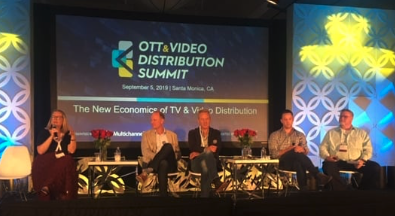The 360 Deal Comes To Video, And It's About Time
Want to make money in the increasingly complicated and contested online-video business? Join the club. But increasingly, the way for a video service to survive and thrive involves doing more than streaming, you know, video.
That was the lesson from a panel I moderated this past week during a conference on OTT services, backed by the venerable TV trade pubs Multichannel News and Broadcasting & Cable.

“You have to go beyond video,” said Eric Berman, head of partnerships and business development for Ellation, part of AT&T's Otter Media and home to VRV, the nerd's fave video bundle, and long-time video services Crunchyroll and Rooster Teeth.
Brands, Berman said, must diversify into merchandise, events, video games, or “whatever you can think of.”
My other panelists agreed, including Richard Cusick, CEO of College Humor's site Dropout: “Everything you do needs to have a merchandising component."
The music business, the choking coal-mine canary of digital media, has been doing 360 deals with its artists for a decade or more, forced by the mid-aughts collapse of the industry's decades-old business structures that relied on music sales.
Now, as streaming is turning upside down traditional TV business models, the idea of building businesses across a broader array of revenue streams is coming to video.
Ellation presides over some of the Internet's most beloved niche video providers. If any smaller video company is well positioned for this 360 era, it should be Ellation, whose units have spent many years building deep audience relationships.
Ellation's Crunchyroll has 2 million paying subscribers, and 50 million registered users, watching a steady diet of anime episodes straight from the mothership, new series debuting hours after they first run in Japan.
Rooster Teeth is even older, its 2003 launch as an online-video purveyor predating even YouTube. Rooster Teeth has been selling video programming such as Red vs. Blue in every conceivable delivery format ever since, building an ardent base of fans and adapting to each new distribution technology as it came along.
And of course, Ellation is bolstered by AT&T's vast resources and vaster online entertainment ambitions. Nonetheless, Ellation's services are continuing to diversify widely within their (significant) niche audiences.
It's proof that even the biggest little guys need to pull every lever, feeding a base of hard-core fans who love, love, love what a service does, and want opportunities to get more of it.
That's why you see Netflix rolling out multiple video games based on one of its biggest, stickiest hits, Stranger Things. It's why Viacom bought VidCon, the huge gathering of social-media influencers now expanding internationally.
Rooster Teeth has its annual RTX gathering, and Crunchyroll now has its own live event. Studio 71, which started as an MCN, is now launching a string of games tied to its talent, among other ventures beyond video.
Basically, you can't count on video, whether ad-supported or subscription-based, to pay all the bills in an era of intense competition that will only get worse in coming months, as big new services attract viewers' money and attention.
That means niche players need to find new ways to take care of the superfans who are the most important part of their fan bases.
The next step, as shown by the VRV bundle, is gathering services and experiences into a batch of offerings at a tempting price that can keep the superfan close by. TVRev colleague Alan Wolk calls it, rightly, the Great Re-Bundling.
“We call it the 360 approach,” Berman said. “It means taking all those formats, bundling them, then putting one price on it.”
VRV includes access to Crunchyroll and Rooster Teeth, but also Boomerang, Cartoon Hangover, Curiosity Stream, HIDIVE, Mondo, NickSplat, and VRV Select, all for a bargain price. Throw in the live events, games, merch, etc. and you're starting to fill the bottomless appetite for more cool stuff in a specific niche.
That other Internet startup Disney is embracing this approach, too, announcing a $12.99 -a-month bundle featuring its new Disney+ service alongside new acquisition Hulu and last year's launch, ESPN+.
That price just happens to be a buck a month less than Netflix's most popular package, as Disney tries to front-load subscriber signups at what is almost certainly a loss-leader price, to ensure it scales quickly. I must say, however, that if you think that package price will last much past 2020, I have a bridge in Brooklyn that I'd like to sell you. I'll give you an amazing deal, honest.
My panel also featured Croi McNamara, SVP of programming for Condé Nast Entertainment, who said just because you have an OTT service, you can't overlook the significant value still to be found on YouTube and other video-friendly social-media outlets.
For CNE, McNamara said, YouTube channels have been an effective test platform for concepts that later become streaming channels or programs for the publisher. For now, Condé Nast is experimenting with streaming channels for Wired and Bon Appetit, based on the strong audience responses to their YouTube content. Sooner or later, expect niche video services from all 17 Condé Nast publications.
And don't rely just on YouTube, once the only online video option that generated much in direct revenue. Now, the social-media video content can occupy several roles, McNamara and other panelists said.
Now, it can be a farm team for the pay site, where content is tested for elevation to the SVOD service. It can be a "barker channel," giving casual fans a tempting taste that may convert them to subscribers. And it can still generate its own revenue, with ad money and sponsorship deals, native content, product placements and more.
The bottom line, literally, here is this: if you want to be in video, be in more than video. Be everywhere your fans are, and make sure they can get all that you have to offer. With all the competition hitting online video in coming months, begging for audiences, it's your best chance to survive.

